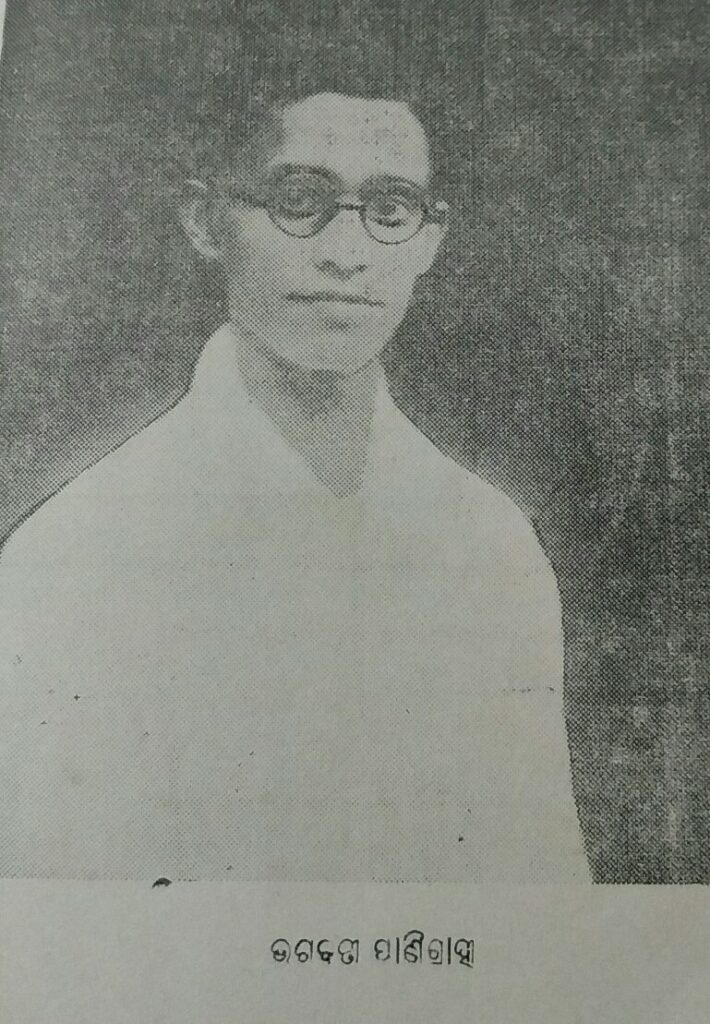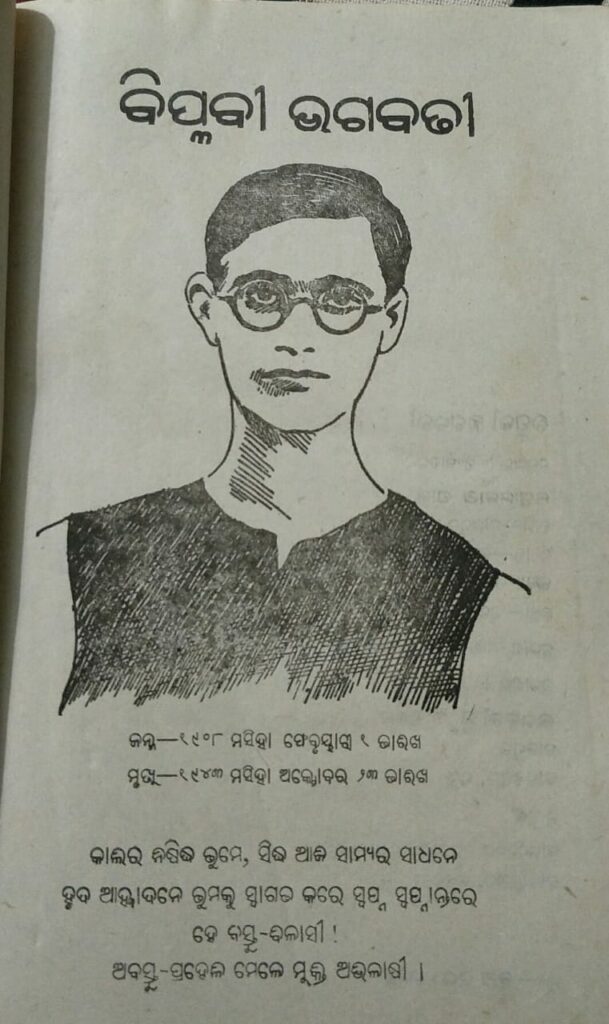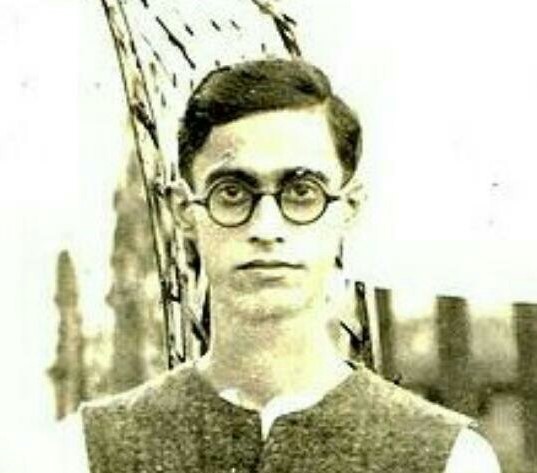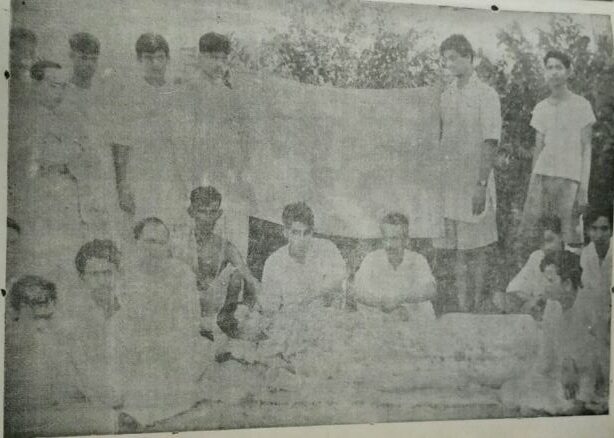Kailash Chandra Dash
Bhagabati Panigrahy’s death anniversary falls on 23rd October.

Famous radical thinker and left activist Bhagabati Panigrahi had a short phase of life as he was born in 1907 and died in 1943. But he had an imperishable contribution to the development of left ideology in Odisha. He was the son of Swapneswar Panigrahi of Biswanathpur near Balipatna of the undivided Puri district. He was a student of Satyabadi School organized by Gopabandhu, Nilakantha, Krupasindhu, Harihara, and others and then left to Puri Zillaschool.
When he was a student of Puri Zilla school he came in contact with ex-detenue Satindranath Guha of Bengal and imbibed his revolutionary ideas. He in 1934 was suspected of being a member of a revolutionary organization in Khurda. Subsequently, he became interested in the Youth League organization. He was also associated with Acharya Narendra Deb and subscribed to his socialistic principles.
He was the founder of Nabayuga Sahitya Sansad at Cuttack with the collaboration of Ananta Pattnaik and others in November 1935 and it became the most famous radical organization to foster modern ideas in Odisha. He edited Odia monthly entitled Adhunika from 1936 May for the spread of progressive and radical ideas. After one year Adhunika merged into the fortnightly Pragati. His Nabayuga Sahitya Sansad became the most progressive center to stimulate considerable interest in radical literature and left ideas among the youth. In December 1936 Jawaharlal Nehru visited Cuttack and addressed the Sansad and his association with the organization undoubtedly attracted and stimulated considerable interest in it.

During this phase, the Sansad sought inspiration and guidance from the All India Progressive Writers` Association which, having as its ostensible program and object the organization of journalists and the promotion of interest in the literature of progressive nature. Nabayuga Sahitya Sansad was well appreciated by Nilakantha Das who in his edited monthly NabaBharata presented an account of its meetings and contributions. His famous story Shikar published in the first volume of Adhunika is a masterpiece of radical Odia literature.
His programs expanded in the 1935s when he became a member of the executive committee of the All Utkal Krushak Sangha and at last was also elected General Secretary of the Utkal Congress Socialist Party. All along he entertained extreme radical views as can be known from his speeches delivered in several Kisan Student and Socialist meetings. His socialist views were also expounded in the weekly Krushak which was also edited by him in collaboration with other young socialist activists of Odisha.
Bhagabati took the opportunity of associating with Rajkumar Singha of the Kakory conspiracy case while the latter visited Cuttack early in 1938. He also kept in touch with noted Bombay and Calcutta Communists. He had also actively participated in the States Agitation and led a batch of volunteers of Dhenkanal State to offer Satyagraha in 1938-39.
He took the lead in directing operations in Dhenkanal State from Budhapanka Camp in Angul and was also responsible fothe r distribution of inflammable leaflets called Ranabheri in Dhenkanal. Then he was rated as an extremist having distinct revolutionary and communist tendencies by the Inspector General of Police in 1939 in colonial confidential reports.

Bhagabati was the official head of the Odisha group of the Communist Party of India and he was the connecting link with the central organization. In April 1938 he had been to Bombay for training in the underground work of the Communist party in the Summer School organized by the Bombay Socialists and on his return, he organized training centers to educate the youths of British India as well as the States in the same way. Bhagabati and his associates were responsible for the spread of National Front Publications in Odisha in 1938.
This National Front was the organ of the Bombay Communists. He was accepted as the leader of the Communists of Odisha particularly Ananta Pattanaik, Biswanath Pasayat, Bijoy Chandra Das, Ashoka Das, and Baidyanath Das were closely connected with him. They all subscribed to the revolutionary Jugantara views. In May 1939 Bhagabati Panigrahi presided over the Puri District Peasants Conference held at Astaranga near Kakatpur.
Panigrahi in his address emphasized on the necessity of the formation of a Peasants Organisation. According to him, the peasant movement was started to strengthen the basis of the Congress movement for the end of British Raj. The peasants` movement was an all India based on non-violence. The aims and objects of this movement according to Panigrahi were to drive out the British from India and also to tackle those who were helping British imperialism in exploitation.
A great reason for starting the movement was to watch as he stated further so that people with vested interest might not capture Congress. The peasants and workers should organize themselves to be ready for the anti-colonial struggle. He further remarked that the peasants and workers should also be careful so that when India was free the country might not fall into the hands of the Black exploitation.
The Sepoy mutiny was staged by the capitalists and therefore it was a failure. In the nationalist movement for the independence of the country, the peasants and workers should fight for their own cause. It was quite likely that they should have to die at the point of the bayonet as was the case in Dhenkanal, Gangpur and Ranpur, but they should remember that such sacrifices naturally would give an impetus to those who were left behind. As this was the last struggle all young and healthy men should take part in it. In the concluding part of his address, he exhorted the audience to unite and form Kisan Sanghas in every village. This address was a remarkable articulation of his brilliant discourse on radicalism.

But as early as April 1940 Bhagabati resigned from the Congress Socialist Party as was reported in Samaj of 24th April 1940 by Surendranath Dwibedi. By December 1940 He was convicted in the Odisha Communist Case along with Baidyanath Rath and Gurucharan Pattnaik and was given 18 months` rigorous imprisonment and fine amounting to rupees hundred.
Bhagabati wrote radical essays in Naba Bharat, Adhunika and Krushak. His first story entitled Jangali was published in Utkala Sahitya in 1929. From 1929 till 1933 he was still not free from nationalist ideas and during this period his articles were published in Sahakara, Bhanja Pradipa, Naba Bharat and Utkal Sahitya which could express his nationalistic ideas and opinions.
But from 1934 he had a new awakening and he became a radical writer. His first radical essays appeared in Sarathi, edited by Nabakrushna Choudhury from 1934 March. A real milestone of his radical philosophy began from 1936 when he edited Adhunika, a progressive monthly from May and thereafter from 1937 his continual association with Krushak made him a famous radical and revolutionary thinker and writer.
In 1940 to 1942 when he was in prison he wrote the History of the World which reflected his left philosophy. During the phase of the Quit India movement, he was still radical as he presented his anti-colonial and anti-imperialist attitude in the weekly Muktiyudhya. From 1942 August for about one year, he was busy touring the villages of Odisha for uniting the people against the Raj.
But his life was cut short by dysentery in October 1943 when he was busy in Ganjam to provide relief to the famine-affected people. BhagabatiPanigrahi spent about a decade from 1930 to 1943 to organise the youth as well as the peasants and workers against the explotative nature of colonialism and imperialism.
During this short span of his life he was very successful in the spread of radical Communist ideas in Odisha. He was not only a harbinger of radicalism in literature in Odia but was also the Bhagiratha of Marxist ideas and consciousness in Odisha.





























